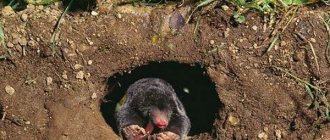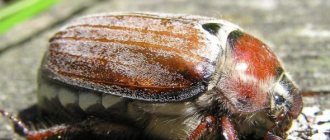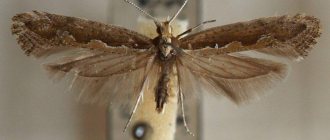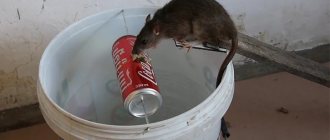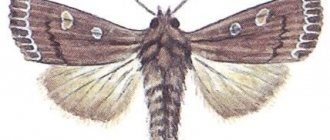The mole is a small mammal covered with fur, unable to see, but perfectly hearing all the vibrations of the earth. Thanks to this, the animal moves well in the dark. It lives and feeds underground, digging huge corridors in which it feeds on earthworms, insects, snails, frogs, and small rodents.
We don't like the mole. And no wonder - in one night it can destroy smooth green grass, undermines the roots of plants, and creates mounds on the surface. How to get rid of moles on your property, folk remedies, poisons and other control methods are described in this article.
You need to know the enemy by sight
Before you start a fight, you need to prepare properly - learn about the strategy and habits of the enemy, which will become a valuable guide to action.
The mole has several features:
- a small rodent with a body length of up to 20 centimeters, black, velvety fur and a rather pleasant appearance;
- at a depth of about 20-50 centimeters below the surface of the earth, the animal digs a system of corridors with a diameter of 6 centimeters and a length of up to 200 meters;
- on the surface the animal creates slides of earth, pushed out of the corridors; the mounds reach a height of several tens of centimeters;
- the rodent patrols the passages every few hours;
- feeds on earthworms, insect larvae, detected thanks to extremely sensitive hearing;
- although it does not feed on plant roots, it can greatly damage them with its activities;
- lives alone;
- is highly active in the morning;
- prefers damp areas, feels great on lawns and beds;
- appears in gardens from early spring to late autumn.
It is worth remembering important features; they are decisive in choosing the method and method of fighting moles in a summer cottage on your own.
A good tip: If mole mounds appear on your property or lawn, use the soil from the mounds to plant potted plants. This land is very fertile.
Biological characteristics
The mole family (Talpidae) belongs to the order of insectivores of the mammalian class. In Russia there are 4 species from the genus of common moles (Talpa) and 2 from the genus Mogera. The appearance of moles is widely known : they have a small, round and elongated body (up to 23 cm long), covered with thick, short, velvety fur of a dark gray or black color; a shortened neck with an elongated head and a small tail (up to 4 cm long); Forepaws turned outward with powerful claws and spade-shaped palms. Small and blind eyes are hidden under the skin above the muzzle with a movable nose-proboscis. There are no external auricles. The number and structure of teeth, depending on the genus of moles, varies from 33 to 44 units. The weight of adult animals is about 170 grams.
Females give birth to 3-9 cubs, which are born blind and naked
In the first half of May, the female hatches from 3 to 9 naked, helpless, but fast-growing cubs, bearing them for 40 days. 6 weeks after birth, the babies leave the nest for underground passages, and at two months of age they are ready for independent life. The lifespan of the animals is about 4 years.
Habitat and lifestyle features
Moles prefer soft, loose, moist, but not swampy soil. Therefore, for a full life, they find fertile places rich in insects. They are not interested in peat or sandy areas.
The purpose of the network of feeding tunnels dug by the mole is that various insects and earthworms fall into them, becoming easy prey. The animal regularly checks the fullness of the passages, and if they are empty, then digs new ones.
Earthworms and insects that fall into mole tunnels become prey for the animal
Moles make their nests from dry branches and leaves or moss underground at a depth of up to 1.5 m, usually placing them in the center of an dug network of feeding tunnels. In summer, feeding passages located at a depth of up to 15 cm from the ground surface are used for hunting; before winter, they break into the lower layer of the earth. In them, animals make chambers, so-called pantries, for storing supplies. To quench their thirst, the animals dig deep vertical passages or lead them to streams and ponds.
The total length of the passages is about 6 m per 1 m2 of area, and the speed of movement of the animals, for example in black soil, reaches 108 meters per hour.
The pest throws excess soil to the surface, and as a result, heaps of earth appear throughout the area where it has settled, which are called “molehills.”
A characteristic sign of the appearance of pests on the site are earthen mounds - mole hills
Having a separate system of passages, animals most often stay isolated from their relatives, with the exception of the mating season. When meeting other individuals in their feeding area, they show aggression. Due to their underground lifestyle, they have practically no natural enemies , except that in rare cases, when they get out, they can become a victim of a fox or owl.
Special glands that secrete a musky odor allow them to attract insects and worms, and their upright growing hair helps them move along narrow earthen passages in any direction.
Animals make their nest in the center of their feeding tunnel system.
A mole can eat an amount of food equal to its own weight in a day , and hunger for seventeen hours leads to its death. Accelerated metabolism and maintaining a constant body temperature force animals to spend a lot of time looking for food, taking short breaks to sleep. 5 hours after satiation, they are ready for a new meal, and between feedings they fall into a sleepy state.
Gluttony is directly related to the replenishment of energy expended on active movements underground by these warm-blooded animals.
In spring and summer, animals include earthworms, beetles and their larvae, and other insects in their diet, and can also attack frogs, lizards and young small rodents . In winter, when the number of insects and their larvae is reduced, the main dish remains worms stored for the winter.
The mole leaves immobilized worms in his tunnels as winter reserves.
The mole paralyzes the worm by biting through the nerve ganglion; as a result, the worm remains lying in the feeding canal. With the help of such reserves, animals spend the winter. In addition, mice and shrews often get into mole passages, which also serve as food for the small predator.
Preventive measures
It is better to prevent an underground inhabitant from settling in the countryside than to fight and save the plantings. Let's start with preventative methods.
Horizontal grids
A special mesh is placed under the lawn at a depth of 10 cm (so as not to damage the aerator holes of the mesh with garden tools). Cover the top of the mesh with soil and sow grass. The mesh creates an insurmountable barrier for the rodent.
This mesh can be used throughout the garden (lawn) for protection.
There is only one problem: this method is only suitable for a newly laid garden or lawn, where it is possible to form the surface and remove the soil. It's hard to imagine using it in an existing garden.
Vertical grid
You can also place a grid around the perimeter of the site like a deep (up to 60 cm) foundation.
Such a barrier around the perimeter of the site will make it highly likely that shrews will not get into the garden.
Stone strip
A stone ribbon around the site can give a similar effect as a deep foundation. The ditch is located along the fence at a depth of more than 60 centimeters, about 30-40 cm wide, and is filled with stone debris and broken stones. Theoretically, this will be an insurmountable obstacle for the pest.
Scare away with smells
It is more difficult to repel moles with odors than insects. If an odorous substance gets into the tunnel, the burrowing animal will make a new move, but will not leave the area. Scented repellents can only work at the stage of development of the site if they are buried along its perimeter or along the fence separating the dacha from the neighboring meadow. Moles come to the garden from the wild because they find more food in the treated and moistened soil.
At a depth of 50-80 cm, you can bury rags soaked in gasoline, waste oil, kerosene, diesel fuel and other petroleum products, which will create a barrier for soil pests seeking to enter the garden. This way you can scare away not only the mole, but also the mole cricket. The smells will last for several years.
Chemical methods
These are not just ordinary poisons. Their role is to deter the enemy, they help drive the mole out of the area.
Carbide
The most popular drug poured into a hole is carbide. The mole's passages are filled with water, this causes a reaction leading to an unpleasant odor that scares away the animal.
Attention! Be careful, the acetylene released is explosive!
In large quantities, carbide is harmful to plants.
Lawn granules and fertilizers
These are special substances, biodegradable and environmentally friendly, dispersed in the garden. They emit odors that moles, and even dogs and cats, cannot tolerate. Because of this, they simply avoid these places.
Another form of granules are special fertilizers that, in addition to lawn nutrients, contain special aromas that repel moles. The most popular fertilizers are with the aroma of lavender; they will protect against moles and fill the area with a pleasant aroma.
Smoke candles
Candles are set on fire and placed in the passages. The smoke fills the burrows, then, when exposed to moisture, produces a lethal rodent-killing agent. There are also candles that are less harsh, aimed only at driving out moles.
Mechanical means against moles
Listed below are mechanical methods that help fight moles in the garden by repelling them.
Tube-shaped mole traps
Special traps have an elongated shape, the entrances are located on both sides, and the latches effectively block the animal passing through them.
Catch a mole in the garden, as experience shows, is not difficult. Traps are placed in burrows. You need to check their contents every day.
The installed trap must be covered from above. Moles really don’t like open corridors - they simply abandon them. You can cover the exit with the trap with a flower pot. Plastic flower pots are very cheap and weather resistant. Their plastic does not deteriorate over time under the influence of frost and ultraviolet radiation. Soil or sand is poured into the pot, and a brick is placed so that the wind does not overturn it.
A mole, deprived of food, dies after 10 hours, so moving quickly along its corridors, the animal will quickly fall into a trap. A caught mole can be released away from housing, for example, in the forest.
Attention! The mole is a predator; its mouth contains 44 very sharp teeth. Care must be taken when catching an animal or removing it from a trap.
Ejector – sound mole repeller
Electroacoustic devices emit sounds that are inaudible to humans and unpleasant to rodents, with a constant or variable frequency (the latter are more effective because the animal can get used to the sound). Ejector repellers are placed in mole tunnels or inserted into an embankment.
Some devices are also a source of vibration, which scares away animals from their summer cottage. The repeller works thanks to batteries - traditional or solar.
Windmills made from bottles
Windmills, located on pegs buried in the ground, emit sounds and vibrate in the wind, transmitting vibrations to the ground.
Empty bottles buried in the ground so that the wind whistles in the upward-pointing necks work successfully. Periodically, the bottles are moved to another place, because the mole can get used to them.
Firecrackers
Special devices filled with fireworks that are installed in an embankment. The mole, touching them, turns on the detector, which launches fireworks. The mole has no chance.
Specialized repellers
Manufacturers of goods for gardeners produce special repellent devices. The principle of their operation is to emit ultrasound or sound waves. Many run on solar panels and do not require a connection to the grid.
You can buy a repeller (Antikrot, Ecotec, Help, etc.) in online stores or retail outlets for gardeners. They are distinguished by ease of installation (you need to stick the device's pin into the soil) and low maintenance. But this method has a drawback: animals quickly get used to the effects of sound and stop perceiving it as a sign of danger.
Natural methods on how to remove a mole from the garden
If you are not satisfied with chemical and mechanical methods, there are still natural or simple methods that help fight moles in your summer cottage.
Plants that repel moles
Some plants planted in the garden repel moles with their aroma and secreted substances. Effective herbal remedies for moles:
- basil;
- marigold;
- garlic;
- black elderberry;
- thuja
Grated cloves of garlic (or cloth soaked in its juice) are placed in mole holes. You can pour humus from black elderberry leaves, garlic or thuja branches into the passages.
Natural barriers - oils
Preparations containing natural oils will repel moles from the garden if used regularly in accordance with the instructions on the package. Oils are sold in the form of concentrates; you need to make aqueous solutions and spray them on the area in your garden plot that is susceptible to mole attacks.
Traditional methods
These methods are a collection of folk wisdom collected from various gardeners and industry forums. Some methods are quite aggressive and are not recommended for people with weak nerves.
- Hair. As it turned out, the mole does not like the smell of human hair. Some gardeners roll up the hair collected after cutting and stuff it into holes.
- Animal fur. The hair of cats and dogs gives a similar effect. If there is fur left after grooming your pet, you should not throw it away; it will be useful as a means to get rid of moles in the garden. The wool is laid out in holes.
- Fish remains - according to reviews, the animal hates the smell of herring. This method was shared by a successful gardener. He buried a piece of raw herring every 1.5 m, and since then the pest has disappeared from the site.
- Kerosene. Some summer residents claim that rags soaked in kerosene placed near burrows effectively repel the pest.
- Animal feces. Moles are especially intolerant of cat feces. In this unexpected way, pets will help fight the pest. It is worth collecting feces and placing them directly in the holes.
- An interesting method for removing a mole from a hole from advanced summer residents is to release carbon monoxide into the hole, obtained from the exhaust pipe of a car or tractor.
- Pouring holes, or flood. Place a garden hose in the hole and let water run for an hour. The mole must jump out into one of the exits, the other exits must be covered. You should place a trap near the exit.
- Vinegar. An effective remedy is vinegar. Dilute the vinegar in a large watering can and pour it into the hole. Over the next few days, repeat pouring the solution into adjacent mounds. Animals do not like the pungent smell of vinegar.
What may shrews be afraid of?
Since moles have practically no developed vision, they receive all information through hearing and smell. However, they cannot tolerate strong odors and sounds, for example, the “aroma” of rotting fish, the smell of valerian, white spirit and other chemicals. Shrews also don’t particularly dislike vibration and loud noises.
How to get rid of a mole in your dacha forever?
Now let's look at more drastic methods of how to remove the pest from a summer cottage.
Poison bait for moles
Poisonous baits (mostly in the form of granules or powder) are very tasty for moles. Poison baits are placed in underground corridors to lure animals.
Traps, mole traps
There are several models of mole traps designed to catch moles, rats, and voles. A hole is opened at a distance of 20 cm and a trap is set. Placement of the trap should be done carefully so that the channel is clean and not contaminated. The clamp is secured with a fixing plate. The trap is covered with turf. Place an opaque bucket upside down on top. The edges of the bucket are sprinkled with soil.
Attention! All operations must be performed with gloves so that the animal does not smell human odor.
Smoke
You can also blow sulfuric acrid smoke into the tunnels, smoke that releases repellent or poisonous gas. For smoke to be effective, it must be used simultaneously in all inhabited burrows. These drugs also work on voles and other rodents.
The mixtures are prepared on the basis of potassium nitrate mixed with powdered sugar. The more sugar, the more smoke.
Be careful! Such mixtures burn intensely, spark, and burning pieces of the composition can fly off, causing burns. Take care of your eyes and skin; you need to set fire to the mixture from a distance.
There are many methods and ideas on how to get rid of moles in the garden. Different methods will be useful in different conditions. The Mole is not an easy opponent and stubbornly returns to its tunnels. When fighting it, you need to remain patient and repeat the procedures regularly. It is better to act differently and try different methods to get rid of the underground tenant of the vegetable garden and garden.
When choosing a method, you should take into account the safety of the inhabitants of the dacha, including pets. Some types of poisons can be eaten by chickens, cats and other pets. Particular attention should be paid to the possibility of children having access to poisons, explosives, traps and snares.

